I spent a little time outside in the run with the girls this afternoon. Our chickens are now 11 weeks old, and growing almost as fast as our spring weeds. For a couple of the breeds, most notably the Golden Laced Wyandottes, and the Delawares, their feather patterns are beginning to look much more adult-like.
This is how the Delawares started out as chicks.
As mature adults the Delawares are an all white breed, except for black barring on the hackles, primaries, secondaries, and tail. The ‘barring’ on the hackles appears almost more as a light speckling.
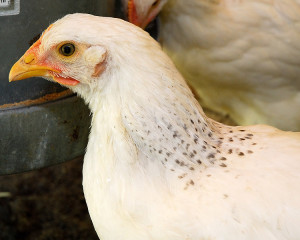
The light black speckles at the base of the neck are typical for hens of this breed (click any image to enlarge)
On some of the Delawares, the black barring in the tail is becoming very prominent.
As it was so warm in the run this afternoon, and a couple of our birds were sunbathing, we were even able to get a good look at the barring on the primary feathers.
As the Delawares continue to grow, the most notable changes will likely be in their faces as their combs continue to grow and mature. As they get closer to egg laying, around early September, the skin around the face will become noticeably more red.
Just as when they were chicks, the Golden Laced Wyandottes probably have the most striking feather pattern of any of the breeds we obtained this spring.
Even the females in this breed have beautiful hackle feathers.
Here you can see that the body feathers are a beautiful golden bay color centrally. As the pullets mature into hens, the golden color will become more prominent.
As they mature the bay coloring fills in, and every feather on the body and wings is edged with an iridescent green-black. Their tail feathers will remain predominantly black.
I’ll try and take a few photographs of the other breeds over the next couple weeks. It was a little challenging in the run, when every chicken kept running up to the camera, and pecking the lens! I ended up with a lot of shots like these this afternoon.
One last update…Frodo. Oh Frodo.
Poor chap is still separated from the rest of the flock, which may make it difficult to reintegrate him later. Although much of his back has now feathered in, he still has one persistent bald spot. Short of crafting him a toupée, or finding the rooster equivalent of Rogaine, we’ll just need to wait it out.
I can attest to the pecking he’ll receive if he goes back in the coop now. After walking in the run today in clogs, with no socks on, I can say that any exposed pink skin becomes an instant target, and these pullets peck persistently…and PAINFULLY!
Now I’m heading back outside to finish building our new chicken run extension…more on that project next week!

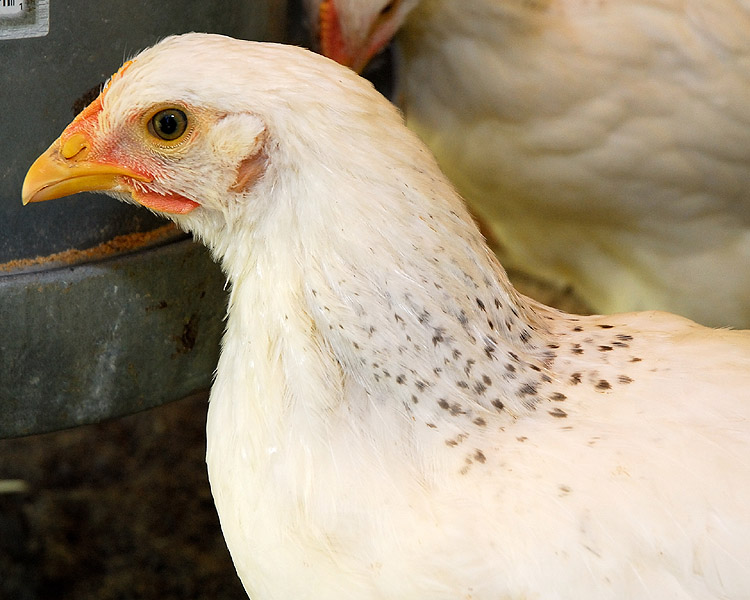

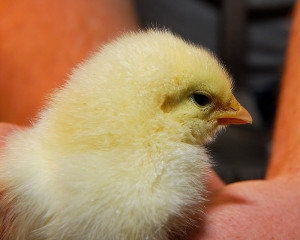

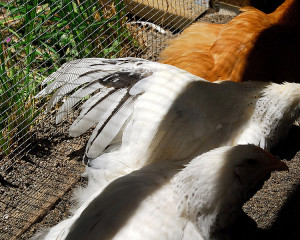
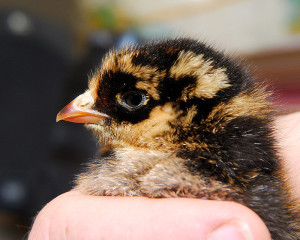
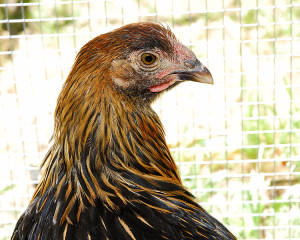
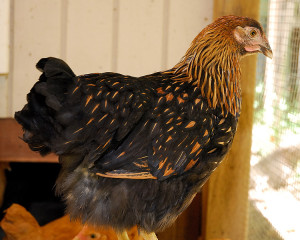
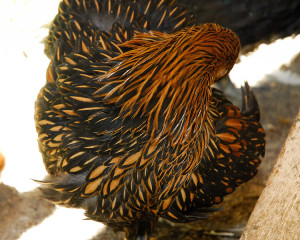
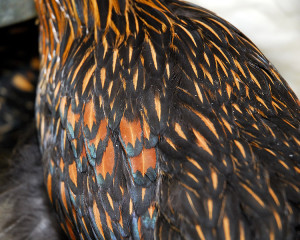
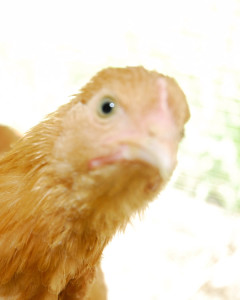
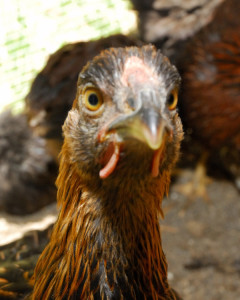
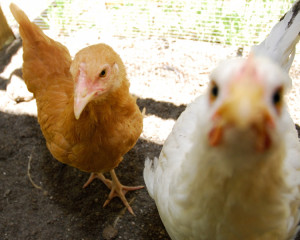
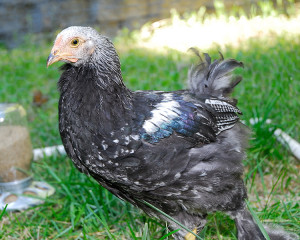
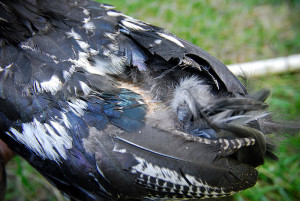







Too funny! I wish the birds I try to photograph would come to peck at the lens. No, soon as you lift the camera, they’re gone.
Poor Frodo! Hope it all works out for him. Must be tough for a guy. (Poor you, as well I guess. Socks next time?)
Socks might not be thick enough…maybe boots instead 😛 Wouldn’t it be nice if all the birds were that curious? I’ve been trying for two weeks to get a photo of our nesting Pacific-slope Flycatcher male, but he seems a bit camera-shy!
The chicks are growing up so fast! Those golden laced Wyandottes are beautiful beasts.
I do love the feather patterns on those golden laced Wyandottes; they always remind me of stained-glass windows.
Oh, I have an almost perverse admiration for the feather pattern on laced Wyandottes…
(And, I’m admitting this on the internets. What have I come to?)
I absolutely love the coloring of your Golden Laced Wyandottes. They are so beautiful! I love the updates on how Frodo is doing 😉
Dear CV,
I have obviously been away a long time as I cannot believe the development which has taken place with the chicken.The markings on them all are so pretty but the Wyandottes are truly remarkable.
My heart goes out to Frodo who even looks quite glum in the picture. I am so pleased that he is in your care and am sure that he will ‘rule the roost’ one day.
I noted that even with pecking to endure you have not succumbed to socks with your clogs. Hardy Amies would be proud.
He does look a bit down in the dumps in that picture. He has friend (a Black Australorp pullet from the flock) that is his room-mate, but I do think he rather misses the flock…except for the pecking that is!
Bald spot aside, I think Frodo is growing into a very handsome chap! I hope he can be re-introduced to living with the others at some stage.
I think of all the chickens we have, he will change the most in appearance as he grows…albeit slowly. As he’s the same age as the rest of the flock, I’m hoping if I slip him in the coop at night, after everyone has roosted, he’ll be more readily accepted. Just probably have a week or so to go before his bald spot finishes filling in…I hope!
It is great to see how the chick’s feathers appear and then later as they grow. Your posts are always filled with such interest and your photos masterful. I look forward to learning about other breeds pecking at your lens but I hope you wear socks to spare your ankles! I do hope Frodo’s bald spot fills in so that he can return to the ladies.
you have just reminded me of a childhood memory. We use to have a chicken coup growing up, and we would often go in to it and collect the interesting feathers (from the ground, not the birds of course) we would then make bird pictures by glueing them onto paper!
Your girls are beautifully coifed! I love birds of all kinds, not just song birds or my precious companion cockatoo, Lola. I really appreciate birds and their qualities. You’re fortunate to have these precious ladies!
We are fortunate, and they’re so much fun. Although maybe not quite as much fun as Lola! 😛
I don’t know much about those birds, but they sure are neat looking. The black and gold ones especially! I don’t think I’ve ever seen a chick like that. I didn’t realize there were so many varieties of chicken…I saw one at a zoo a couple of years ago, it had fluffy feet. Like it had feather leg warmers…LOL
Kyna, you can’t see it here, but Frodo has those same fluffy legwarmers. I have a photo of his feather bedecked feet in this post if you missed it:
https://curbstonevalley.com/blog/?p=2221
Add to that, when he’s mature, he’ll fall somewhere in the 12-14lb range…HUGE for a chicken! He will be a force to reckoned with in the hen house then 😛
Poor Frodo! I’m afraid I would make him my pet! Your chicks are becoming quite beautiful. It is great fun to watch them grow. I love the shots of them looking at the camera lens!
Frodo is definitely a pet. I actually think he’s going to be a really sweet rooster. Much nicer that our Partridge Plymouth Rock rooster will be…he’s already a bit feisty, although we’re trying to work on befriending him.
I want a Golden-Laced Wyandotte!
Those pictures of the camera curiosity are too cute. They look ready to speak somehow. 😉
And oh, my heart goes out to poor Frodo. He’s going to be so beautiful one day, I just know it, and I’m crossing my fingers that eventually his separation from the flock will be but a distant memory.
Aren’t the Goldens lovely? Not the friendliest birds in the coop…for that the award goes to the Delawares. The Dellies are unbelievably curious, but amazingly sweet and friendly. The Golden’s were ones doing most of the ankle pecking yesterday…and they only get away with it because they’re so pretty. Next time though, I’m wearing boots!
Its so lovely to see all the various colourations starting to develop Clare despite the pecks you got in the process.
What lovely ladies!!!!
Looks like the camera (and the photographer) are quite the attraction for the ladies!
My heart goes out to Frodo. May his bald spot soon disappear, even as mine gets larger! 😉 Thanks for the updates.
They are so pretty, I really love the different feather patterns. I sure hope Frodo can eventually join the girls. I never knew they’d go after bare feet, that’s a good thing to remember.
The golden laced Wyandottes are very impressive – old fashioned looking to be sure. I love all the photos of the hens all peering at the camera!
I like the golden laced pattern. It just calls out to be embossed on something, but what?
I love the photos from chick to pullet!
The GLW’s are pretty stunning, but those blue feathers of Frodo’s are fabulous! He’s going to be quite a looker!
I just love this blog. The photos are all great, and everything is so thoughtfully written. Great job! Your birds are growing so nicely, I cracked up at the lens closeups! Really, chickens are wonderful. I agree with the other commenter, Frodo would probably be in the house with me, I’m such a nut. He’s just a love!
Yikes! I didn’t realize that I’d have to wear close-toed (and close-healed!) shoes around the hens when they get older…